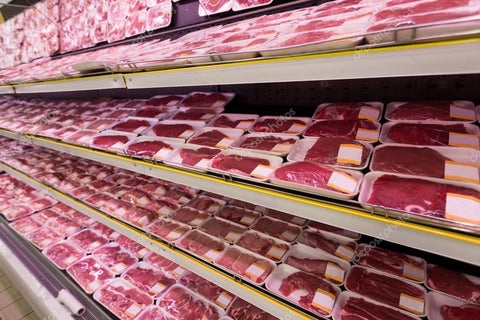Why Frozen Meat is Better
The debate as to whether or not you should freeze your meat products is a valid one. In order to keep them fresh for longer periods, it makes sense to freeze your pork loins and beef mince, but doesn’t that diminish its flavor and just make it more watery when you eventually get around to cooking it? Not necessarily. There are ways you can mitigate the formation of ice crystals in your meat if you’re careful in how you go about freezing it, thereby preventing the damage to the meat’s cell membranes caused by freezing the meat too slowly.
The easiest thing to do here is to vacuum-seal your meat, removing any air that may come into contact with the muscle fibers and allow more space for ice crystals to form and thereby damage the meat’s connective tissues. Buying your meat already frozen is an effective way to cut down on costs, as you can often bulk-buy poultry and other red meats as the airtight bags in which they are sealed occupy less room than the packaging of fresh meat products. But there are a few other benefits to getting your meat from a freezer unit rather than the refrigerator aisle at your local grocery store.
Why do you want your meat frozen?
Despite the many myths surrounding the loss of nutritional value that comes from freezing meat, there are negligible downsides to be incurred in doing so. If nothing else, you want to freeze your meat for the convenience it offers you to plan far ahead without having to worry about your beef sirloin going off or whether you’ll be able to find the time to cook up your beef short ribs at the end of a busy week.
Happily, freezing any kind of food product does little to affect its fiber content, calorie count, or the amount of minerals you can get out of it; you won’t see any changes in the product’s fat, carbohydrates, protein, or sugar levels, either. Just about the only nutritional aspects of the food to see any kind of difference will be the folate levels and vitamin C content.

There is one other benefit to cooking your meat from frozen, especially if you are running a restaurant. As the meat thaws, it will produce a small puddle of water that will also contain some of the water that is put into meat products by suppliers, in a bid to increase their individual volume. What this means is that, when fully thawed, the meat will present its actual size and can give you a clearer idea of how to list their product on your menu. The size you promote is the size you sell.
Is most meat in supermarkets previously frozen?
Yes, is the short answer to that one, due to the fact that most food in the US is shifted around the country in large freight trucks. But meat in particular, as well as poultry and egg products, can switch between numerous vehicles in their journey from the producer to the retailer. As such, meat will necessarily need to be frozen in its journey from point A to B – or even points C or D, depending on where in the world it ends up – in order to ensure it is fresh for consumption upon reaching its destination.
Most commercial suppliers will quickly freeze their meat products in a blast freezer to limit the size of the ice crystals as much as possible, thereby reducing any damage that may occur to the meat’s muscle fibers. A typical food shipment can make its way through airport holding facilities, railway storage units, and many other kinds of warehouses and industrial refrigerators, meaning a more pronounced risk of human contamination.

The kind of meat produced from the specific animal slaughtered determines whether it will be processed or frozen for transport, with each meat product requiring its own handling and packaging guidelines. While frozen meat lasts for a virtually indefinite span of time, and can thus find its way toward different continents with little ease, fresh meat products have an expected shelf life of two days and will not be expected to cover such long distances in the back of a truck.
How to safely thaw meat
To ensure your meat is thawed all the way through, with no excess ice crystals that can affect the overall tenderness of the meat as they melt, it’s important to thaw your meat properly. There are a number of ways to do this, with the safest one being to defrost your meat in a refrigerator by wrapping it in aluminum foil or cling film and putting it on the bottom shelf to prevent any moisture dripping onto food below. You will need to allow for 24 hours of thawing time for every five-and-a-half pounds of meat.
Another method is to thaw the meat in a bowl of cold water, provided it is tightly wrapped in waterproof material. You will need to change the water every half-hour, leaving any time between one hour for a 500g meat product to over two hours for a package weighing more than 4.4 lbs. That said, some food items can be thawed as they cook, providing they aren’t particularly thick or dense items; burger patties, for instance, can be thawed as you cook them.
When transporting any kind of meat, it’s vital that it is refrigerated properly and that the distance between supplier and consumer is as short as possible. When transported, meat should be wrapped in sealed, airtight packaging to prevent any moisture or condensation forming on the product, which could then form ice crystals; and the transportation units should provide refrigeration below 40˚F.
Fortunately, at Buffalo Market we are keen believers in the farm-to-fork principal of food production, which cuts down on the journey times of food delivery, limits the risk of contamination through human contact, and keeps produce fresh. Nurturing close relationships with local, independent producers all across California, we are able to give you the best organic produce possible at the most competitive prices. Within our growing inventory of more than 2,600 items, we can provide your restaurant from everything to herbs and vegetables to pasture-raised chicken. We also have a wide range of plant-based meats, keeping up with one of the biggest food trends of recent years by giving you Beyond Meat sausages, Lightlife plant-based burgers, and many other popular favorites.
No matter what you need for your restaurant – including all kinds of marketing and management tips in our restaurant owner’s blog – Buffalo Market is there to provide the very best the state has to offer, and all delivered straight to your door. Take a look at some of the incredible deals we have in our range of wholesale goods and taste the difference today.


